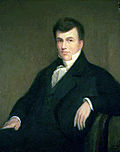| | |||||||||||||||||
| |||||||||||||||||
| |||||||||||||||||
 County results Jennings: 60–70% 70–80% 80–90% >90% Harrison: 60–70% 70–80% 80–90% Unknown No Vote | |||||||||||||||||
| |||||||||||||||||
| Elections in Indiana |
|---|
 |
The 1819 Indiana gubernatorial election took place August 2, 1819. The incumbent governor Jonathan Jennings defeated the former lieutenant governor Christopher Harrison. [1]
Contents
Jennings announced his candidacy in May, following weeks of speculation. For some time the identity of his opponent remained uncertain. Harrison entered the race on July 3 and quickly emerged as the main challenger to the incumbent. Other possible candidates, including the judge of the Indiana Supreme Court Jesse Lynch Holman, declined consideration. [2]
Jennings's role in negotiating the Treaty of St. Mary's was a major issue in the campaign. [2] In 1818, Jennings was appointed one of three federal commissioners to negotiate the cession of principally Miami and Potawatomi land in Northern and Central Indiana. [3] Critics claimed Jennings's acceptance of the commission violated the state constitution, which prohibited the governor from simultaneously holding federal office. Acting on this interpretation, Harrison announced that Jennings had abandoned the governorship and briefly took possession of the state seal. The Indiana General Assembly conducted an investigation but declined to remove Jennings from office, whereupon Harrison resigned as lieutenant governor. [4]
The Democratic-Republican Party was dominant nationally, and the politics of the state were conducted on a nonpartisan basis. [5] Jennings's opponents framed the election as a referendum on the legality of the governor's actions during the treaty negotiations; his defenders responded that the importance of the territory opened to settlement by the "New Purchase" outweighed the constitutional question. Jennings was accused of being a Federalist and an alcoholic and charged with corruption in his management of the Bank of Indiana. Harrison, in contrast, was praised for his integrity, Republicanism, aversion to banks and speculation, and strict observance of the laws and the constitution. [6]
The election result was a personal vindication of Jennings, who defeated Harrison by a large majority. [7] Voters rewarded Jennings for his role in the acquisition of new territory, while the governor's enduring popularity from his long service as the U.S. delegate representing the Indiana Territory's at-large congressional district was reflected by his strong showing in the western part of the state. [8]

